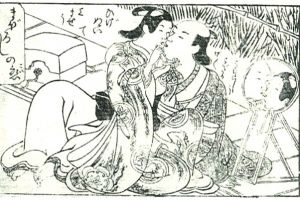Nenja

Nenja (念者, "lover" or "admirer"), in premodern Japan, was a term applied to the older and sexually active male partner involved in a homoerotic relationship with a wakashū (若衆, "youth"), a sexually passive adolescent boy, in the context of the historical practice of shudō (衆道,"the way of youths"), also known as nanshoku (男色, "male love"), which was customary among members of the Buddhist clergy and of the samurai class.
The sense of the word can be rendered as "a person who thinks of a particular youth", the character nen (念) being of difficult translation, as its meaning falls somewhere between rational "thinking" and emotive "feeling". Unlike the term wakashū, its counterpart nenja had no age signifier, although it was expected in principle that the lover would be older than his beloved.[1]
References
- ↑ Gregory M. Pflugfelder, Cartographies of Desire: Male-Male Sexuality in Japanese Discourse, 1600–1950 (Berkeley: University of California Press, 1999), p. 36.